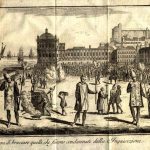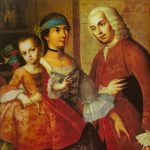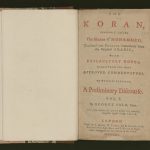By Susan Zakaib
Sometime in 1737, a Catholic priest climbed into a canoe to save his parishioners’ souls.
The cleric in question, Bernardino Pablo López de Escovedo, was a humble vicario—a parish priest’s assistant—working in a parish called Xaltocan, north of Mexico City. Xaltocan’s head priest had fallen ill and abandoned his post, leaving López de Escovedo to handle the parish on his own.
The timing could not have been worse. A horrific epidemic—which would kill about 200,000 people by 1739—was devastating central Mexico, and by 1737 it had reached Xaltocan. As the area’s sole remaining cleric, López de Escovedo’s priority was to conduct confession for all his sick parishioners before they died. The task was not an easy one: so many died so rapidly that López de Escovedo had trouble keeping up. He became so busy giving last rites that, “three days of the week, he could not eat more than a mug of chocolate, from the… time when he went out—two in the morning—until he got back at eleven or twelve the next night…”
During his long working hours, López de Escovedo was surrounded by death. According to his account, his indigenous parishioners were afraid to touch the corpses of their brethren, and often refused to bring him the bodies of the dead. To ease their fears, “although dressed in a cloak and surplice, he lifted the dead with his own hands, placing them in the casket,” so that they could be buried. At other times, López de Escovedo brought the ill together so he could deliver last rites for all of them at the same time. To ensure that parishioners did not overhear one another during this private ritual, the priest “was obliged to use his sash to cover his face and that of the sick person, suffering the intolerable smell and sweat that they left imprinted upon his face…”
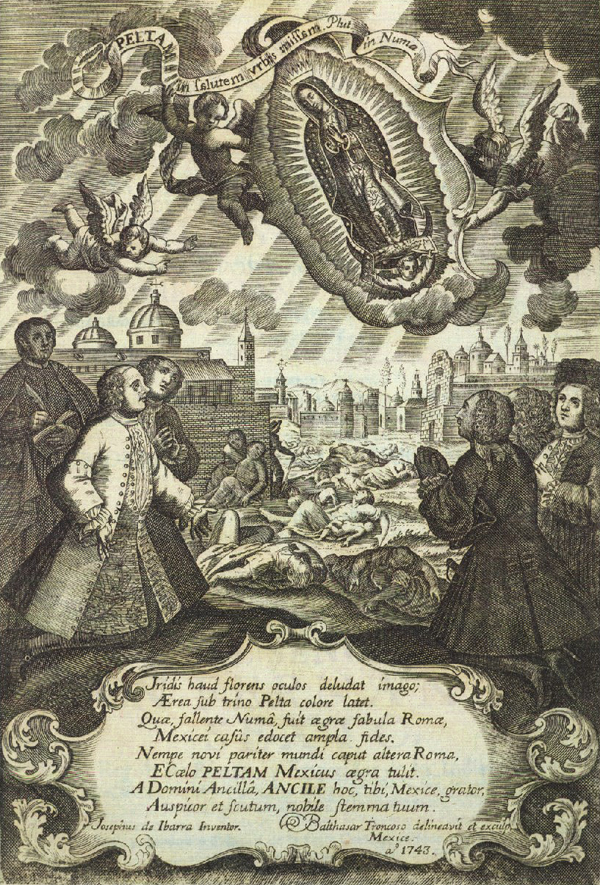
The Virgin of Guadalupe watches over the dead during the epidemic, which contemporaries referred to as “Matlazahuatl.” Fontispiece from Cayetano Cabrera y Quintero’s Escudo de Armas de México, 1746.
The epidemic soon reached a small island, which lay in the midst of the now-defunct Lake Xaltocan. In a little chalupa (a type of canoe), López de Escovedo and a sacristan (church caretaker) traversed the lake’s choppy waters to conduct confession for the island’s sick and dying. The stormy lake proved too much for the small boat: during the hour-and-a-half-long journey, “the waves came up with such ferocity that the boat was about to sink…” The sacristan “went along draining the canoe with his hat unceasingly,” and managed to keep them more or less afloat. Meanwhile, López de Escovedo found himself submerged in water, holding up the consecrated host in hopes of keeping it dry. Finally, they arrived at island and, “by the divine and immense piety of the Lord, even with all these dangers and discomforts… not one sick person died without having first received the Sacraments of Penance and Last Rites.” Many perished on that small island, but thanks to López de Escovedo’s dedication, every soul was prepared to enter the next life.
This story is remarkable in its detail and dramatic flair. Yet its source is not a novel or a historical opus; rather, it is part of López de Escovedo’s resume.
Given that the purpose of López de Escovedo’s resume was to impress his superiors, we can’t know for sure whether his tale is true. In colonial Mexico, priests who sought a benefice (paid jurisdiction over a parish) submitted méritos—lengthy resumes of anywhere from 3-10 pages–to a committee of ecclesiastical examiners. Priests used their méritos to state their qualifications and explain to these committees why they should receive a parish post. López de Escovedo may well have embellished his tale to portray himself as a hero; perhaps his parishioners saw his deeds in Xaltocan differently.
Regardless of their authenticity, stories like this one were common in the resumes of colonial-era priests. Most clerics used their méritos to state who their parents were, describe their educational background and academic accomplishments, list their previous parish experience, and note their accomplishments during past assignments. Like López de Escovedo, many also included stories about their experiences on the job. While most of these narratives were less hyperbolic than López de Escovedo’s, they tended to share similar characteristics: they highlighted the suffering these men had endured as parish priests, and their perseverance in the face of adversity.
While to modern readers the inclusion of such melodramatic episodes might seem counterintuitive, this was a sensible tactic in the context of the 18th-century Mexican Church. Most priests in central Mexico during this period owned a copy of the Itinerario para parochos de indios, a manual for priests’ duties written by Alonso de la Peña Montenegro, bishop of Quito, and first published in 1668. Montenegro quoted the decrees of the Council of Trent—another book that priests frequently carried with them—which stated that the duties of a parish priest were “such a laborious burden that the shoulders of angels were afraid to carry it.” He argued that shouldering this burden was a Christ-like act, since serving as a parish priest was “so difficult and overwhelming that Jesus Christ himself felt its incomparable weight” when he served as the pastor and guardian of disciples who he knew would betray him. Having learned from Montenegro that their hard work and sacrifices made them Christlike, many priests must have felt that the difficulty of administering parishes was what made the job worthwhile.
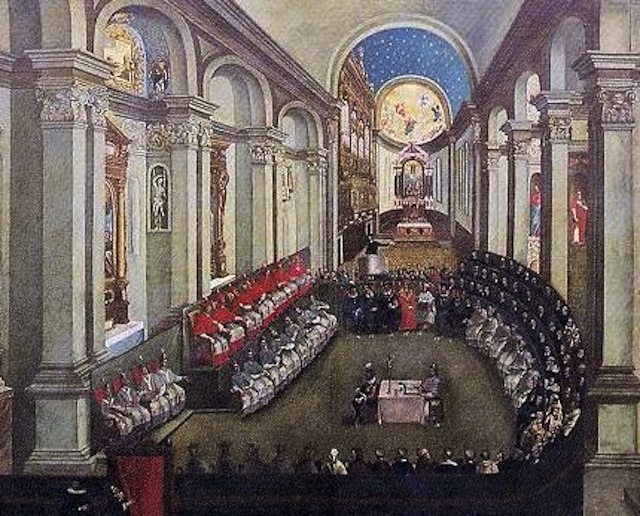
The Council of Trent meeting in Santa Maria Maggiore church, Trento (Trent). (Artist unknown; painted late 17th century). Via Wikipedia.
However, not all clerics included stories of pain and perseverance in their méritos. By far, clergymen who were relatively poor and undereducated were most likely to take this approach. Priests who were wealthy and very well-educated had plenty to boast about without resorting to dramatic tales: they could list their extensive academic achievements, mention the important people they knew, and describe the expensive gifts they had lavished upon their parish churches. Dr. Joseph Francisco Vásquez de Cabrera, who applied for a benefice in 1709, was one such cleric. Dr. Vásquez wrote in his méritos that he had not bothered to list his accomplishments in university, since he had always been at the top of his classes. Nevertheless, he spent pages painstakingly noting every examination, thesis defense, and public debate that he had completed during the course of his studies. He also stated that, during his time working as a parish priest, he had built a new chapel, adorned the altar, and added a “very expensive” sculpted silver and gold cross, among other generous donations.
Lacking such boast-worthy accomplishments, clergymen with fewer funds and degrees often highlighted their perseverance instead. In doing so, they proved that they had earned a promotion, that they were willing to undergo what they saw as Christlike suffering, and that they had what it took to fulfill their duties under harrowing circumstances. Hence López de Escovedo’s epic narrative. Although he had done well in school, his dismal finances prohibited him from continuing his academic career beyond his bachelor’s degree. With his vivid story, he sought to show that what he lacked in educational accolades, he made up for with nearly boundless dedication to the Church and to the spiritual wellbeing of his parishioners.
López de Escovedo’s strategy appears to have worked: after submitting his méritos in 1749, he received the benefice of Oapan, in modern-day Guerrero. Yet his success paled in comparison to that of Dr. Vásquez, who attained the benefice of Taxco in 1710. Also in Guerrero, Taxco was a much more desirable benefice than Oapan, with a significantly better salary. Although López de Escovedo’s gripping resume was enough to land him a job, his perseverance was no match for education and wealth.
This article was originally published on the author’s website on September 15, 2015
Material is from my forthcoming dissertation, “Built Upon the Tower of Babel: Language Policy and the Clergy in Bourbon Mexico,” The University of Texas at Austin, 2016. Méritos of Bernardino Pablo López de Escovedo and Joseph Francisco Vásquez de Cabrera are located in the Archivo General de la Nación in Mexico City (Bienes Nacionales 199, exp. 12 and Bienes Nacionales 338, exp. 2 respectively).
